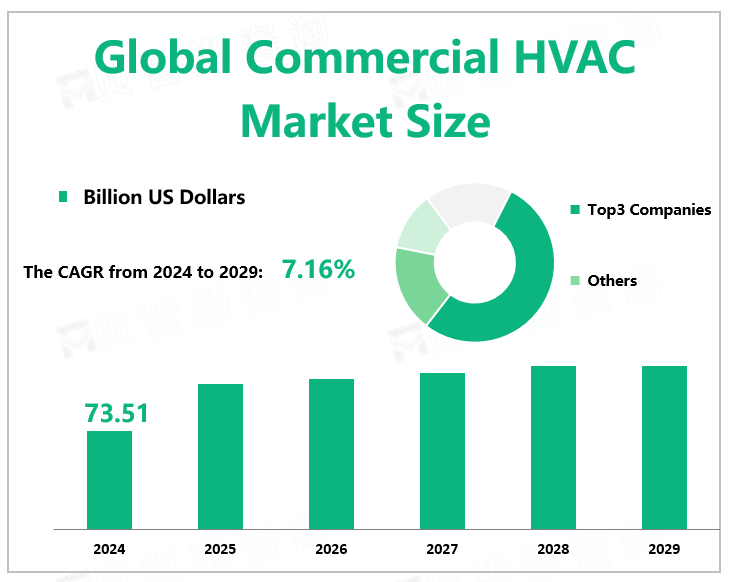Global Commercial HVAC Market Overview
According to Global Market Monitor, the global commercial HVAC market will be $73.51 billion in 2024 with a CAGR of 7.16% from 2024 to 2029.
Heating, ventilating, and air conditioning (HVAC) equipment perform heating and/or cooling for residential, commercial, or industrial buildings. The HVAC system may also be responsible for providing fresh outdoor air to dilute interior airborne contaminants.
Market Drivers
The increasing emphasis on energy efficiency and sustainability is expected to drive the commercial HVAC (heating, ventilation, and air conditioning) market. Demand for energy-efficient HVAC systems is rising as companies and governments introduce policies to reduce their carbon footprint and operating costs. For example, the U.S. Department of Energy sets minimum efficiency standards for air conditioning and heat pump equipment. It requires all HVAC manufacturers to redesign air conditioners to improve energy efficiency, effective Jan. 1, 2023. These government regulations have had a significant impact on the HVAC industry.
The integration of advanced technologies such as the Internet of Things and artificial intelligence into these systems is further driving the market. These advancements enable predictive maintenance, real-time monitoring, and optimal energy use to improve the overall efficiency of commercial HVAC systems. Ai's ability to analyze large amounts of data in real-time enables the development of intelligent HVAC systems that optimize energy use, reduce operating costs, and improve indoor air quality. These intelligent systems use the predictive power of AI to anticipate changes in weather conditions and occupancy patterns and adjust operations accordingly to ensure optimal comfort and energy efficiency.

Application Fields
Demand for new commercial building facilities, multi-family residential properties, data centers, and advanced technology Spaces is increasing. Governments in developing countries are investing in construction to meet the growing demand. HVAC systems have multiple uses in commercial buildings, and with the growing number of office buildings, shopping centers, and other commercial structures, the demand for efficient heating, ventilation, and air conditioning systems is rising rapidly, a trend that is expected to drive the market significantly in the coming years. The construction industry plays an important role in driving system demand. With the increase in the construction of commercial and residential buildings, the demand for equipment and services has been increasing, thus driving the growth of the market during the forecast period. In addition, tubeless systems are efficient and flexible. Tubular systems are very suitable for residential construction. Most countries in the Asia-Pacific region prefer tubeless air conditioning because it is more economical and consumes less energy than central air conditioning. Tubeless systems can be used to heat and cool the entire house, or installed in new rooms, individual rooms, or basements to ensure a zoning solution.
|
By Application |
Retail Industry |
|
Office Building |
|
|
Hotel |
|
|
Restaurant Industry |
|
|
Bank |
|
|
Data Center |
|
|
Others |
|
|
The office building segment occupies the biggest share. |
We provide more professional and intelligent market reports to complement your business decisions.